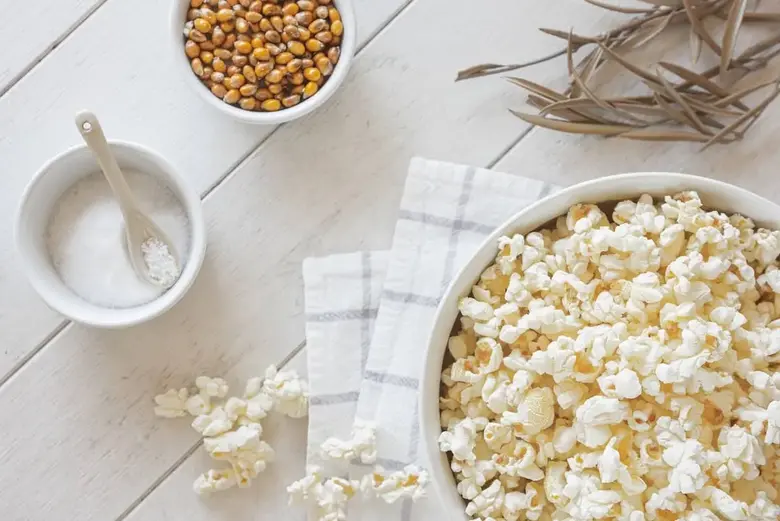Mushy Popcorn - And Other Popcorn Mistakes

Making popcorn seems like an easy task until you end up with gummy, chewy popcorn.
Why is my popcorn gummy? The main reason that popcorn is gummy is that steam is trapped in the pot while the kernels are popping. You can avoid this when popping by using a well-ventilated lid or by leaving it slightly open for light, crisp popcorn.
In this article, you’ll learn how to make popcorn that isn’t gummy and what other popcorn mistakes to avoid.
Why is my popcorn gummy?
The main reason why popcorn is gummy is that steam is trapped in the pot or popcorn maker.
There is already moisture in each grain. When the beans are heated, that moisture turns to steam, causing them to burst. Afterwards, the steam collects in the pot or in the popping machine.
This can lead to excess moisture in the pot or popping if they are not well ventilated.
There are two other factors that cause chewy results:
First, when you wait too long to eat your popcorn, it becomes rubbery and mushy. Popcorn is at its best a few minutes after being popped. The longer you leave the popcorn uneaten, the more moisture it will absorb from the air.
And secondly, using too much oil can also cause your popcorn to be chewy. In general, 1 tablespoon of oil to ¼ cup of kernels is a good ratio to prevent popcorn from becoming too soft.
How to make popcorn that is not soft?
Letting the steam out when making the popcorn is the key step to prevent it from getting gummy.
Whether you popcorn on the stove, in a large pot, or in a popcorn machine, make sure they are well ventilated so that steam escapes from the popping kernels. If your pot lid doesn’t have holes or is too tight, leave it slightly open.
Once the popping is over and you can count 3 seconds between poppings, turn off the heat and remove the lid. The sooner you let the steam out, the lighter and crispier the popcorn will be.
Transfer the popcorn to a large bowl and wait a few minutes to eat it. Do it so that all the moisture evaporates, even if you are dying to eat them.
If you have guests over and want to make sure you serve them crispy popcorn, serve it in paper bags. These will absorb the moisture from the popcorn.
To make your popcorn chewier, you can try spreading it out on a baking sheet and popping it in the oven for a couple of minutes. Keep the heat low so you don’t burn the popcorn kernels, but just crunch them a little.
5 Other Popcorn Mistakes You Should Avoid
If chewy popcorn isn’t something you struggle with, here are some other common popcorn mistakes. Unless you’re a popcorn pro, chances are you’ll make at least one of them.
1. Not Storing Beans Properly
What can be worse than some chewy popcorn? The popcorn that doesn’t pop at all!
Store the popcorn in a tightly closed container or bag in the pantry or somewhere cool and dry. Do not leave the container with the popcorn open and do not store it in the fridge or freezer.
Storing unopened popcorn properly preserves the moisture level of the kernels and ensures that they will pop.
2. Putting too many beans in the pan
If you put too many beans in the pan, you risk burning at least half of them. While you wait for some beans to pop, the ones that are done will burn.
With a quarter cup of kernels you can make about two bowls of popcorn. Therefore, it is not necessary to use a large amount.
3. Not heating the pan before adding the beans
The pan must be well heated before adding the beans. Also, you need to lower the heat so that the beans heat up evenly. With high heat, you will only burn one side of the beans.
Also, shake the pan often to make sure all the kernels get hot and pop.
4. Salting the popcorn too soon
Some culinary sources suggest salting the popcorn ahead of time. However, many others have shown that salting the kernels while they are still popping makes the popcorn tough.
Add the salt and other spices once the popcorn is done and out of the pot.
5. Using the wrong oil
You cannot use just any oil to make popcorn.
First, use a neutral-flavored oil or an oil that works well with popcorn in flavor. Neutral-flavored vegetable oils are a good choice.
Second, make sure the oil you use has a high smoke point.
Lastly, choose an oil that is thin enough to evenly coat the kernels when heated, but thick and firm when the popcorn has cooled. This will prevent the popcorn from being oily and slippery. In this sense, coconut oil is the best.











